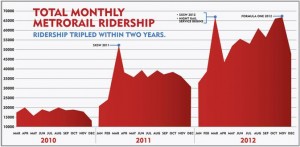All about the community of model railroading and rail enthusiasm
January 29, 2013 / Updated September 18, 2013
AUSTIN, TX – With double the ridership on its light rail line, Austin’s Capital Metro closed out 2012 with a ridership increase that exceeds the nationwide pace of mass transportation growth.
Capital Metro reported today that the agency posted ridership growth of 4.7 percent in 2012, almost double the increase for national public transportation. Capital Metro increased trips 1.5 million over 2011 to finish the year with more than 34 million boardings. Nationally, public transportation ridership increased by 2.6 percent during the first three quarters of 2012, according to the American Public Transportation Association (APTA).
 MetroRail hit a milestone of its one millionth passenger trip, and ridership increased nearly 50 percent in 2012 over 2011. Ridership has increased in part due to extended evening service on Fridays and Saturdays, which is now averaging 2,200 trips per weekend.
MetroRail hit a milestone of its one millionth passenger trip, and ridership increased nearly 50 percent in 2012 over 2011. Ridership has increased in part due to extended evening service on Fridays and Saturdays, which is now averaging 2,200 trips per weekend.
MetroRail ridership has tripled since service began in 2010.
“We are attracting new daytime riders from our evening service,” said Vice President of Marketing and Communications Dan Dawson. “People are experiencing the ease and comfort of riding the rails at night, and get hooked and decide to try it for getting back and forth to work.”
Transit officials say MetroRail is a key part of the larger overall regional system for high-capacity transit in Central Texas. In addition to ridership milestones, Capital Metro it is contributing to the economic vitality of the region, with more than $95 million in new development built near MetroRail stations, and another $283 million in various stages of new development planning.
System-wide, Capital Metro provided an average of 112,000 rides each weekday.
“The ultimate endorsement of our service is that so many people choose to ride with us,” says Capital Metro President/CEO Linda S. Watson. “High gas prices and a strong local economy are certainly factors, but we’ve also improved nearly every aspect of our business, with updated and streamlined routes, new buses and better information at bus stops.
Fixed-route bus ridership is on a 22-month growth streak, due, in part, to the agency’s implementation of ServicePlan2020, a comprehensive roadmap to reinvent Capital Metro’s bus system by 2020. As part of overall gains in trips taken, the agency saw a marked increase in ridership among Austin Community College students and faculty (eight percent increase) and city of Austin employees (30 percent increase).
“Every bus line in the system was reviewed, and thanks to the strong leadership of our board and President Watson, we’ve been systematically incorporating changes to routes since 2010 to improve the efficiency and productivity of the bus system,” says Vice President of Planning Todd Hemingson.
Capital Metro is currently engaged in a regional planning effort through Project Connect, a collaboration of Central Texas transit and government organizations. MetroRapid, MetroRail, express lanes and additional rail projects are some of the components included in the vision of Project Connect.